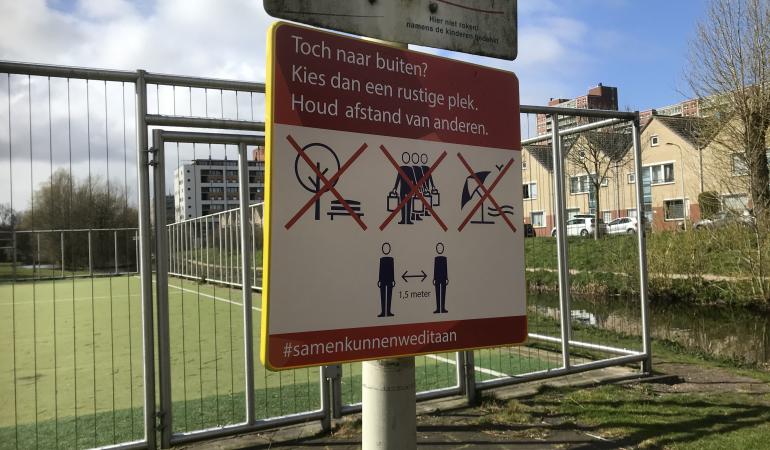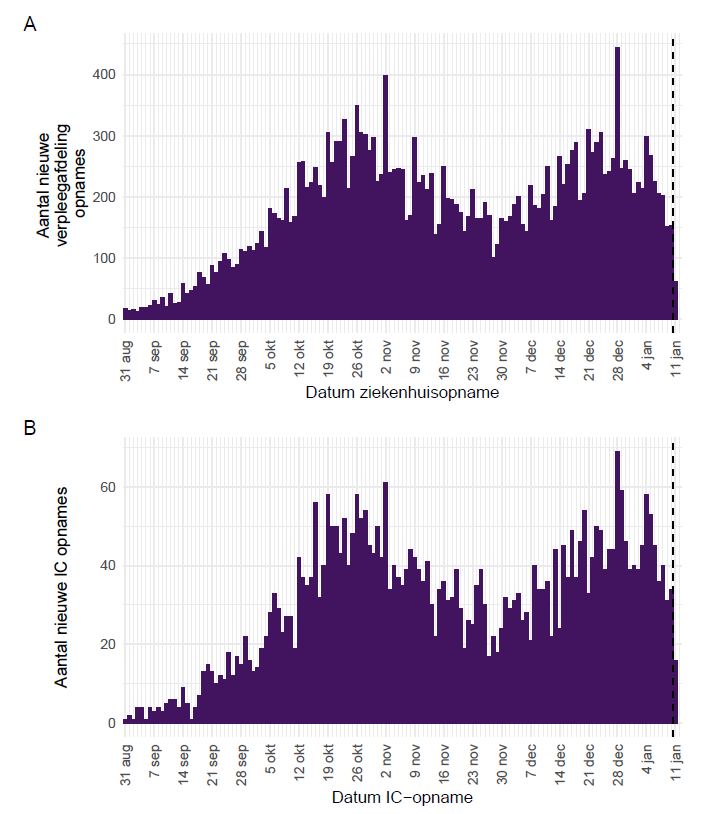
For the second week in a row, the number of newly reported COVID-19 infections decreased somewhat in the Netherlands. The percentage of people who tested positive for COVID-19 decreased slightly, dropping from 13.7% to 12.8%. The number of hospital admissions and ICU admissions were lower than in the week before. Also, fewer new nursing homes with COVID-19 infections were reported. The decreasing figures are the initial effect of the lockdown that started on 15 December.
Reported figures
In the past week, from 6 to 12 January, the reported number of people who tested positive for COVID-19 was 49,398. This is a decrease of 12% compared to the week of 30 December to 5 January, when there were 56,440 newly reported infections. The percentage of people who tested positive for COVID-19 decreased slightly, dropping from 13.7% to 12.8% last week. The number of people who were tested last week was 340,285, a decrease of more than 27,800 tests (-8%) compared to the week of 28 December to 3 January. The Infection Radar also showed a decrease in the percentage of people with symptoms resembling COVID-19.
The decrease in the number of people who tested positive for COVID-19 is primarily visible in the reported test results for people aged 30 years and older. The number of reported positive tests per 100,000 people was about the same as the week before in the age groups of 0-12, 13-17 and 25-29 years. In the 18-24 age group, the number of reported positive tests increased by 12% (Figure 1).
Figure 1. Number of reported positive tests per age category per week.
Situations where infection may have occurred
In the past four weeks, more than half of the new people who tested positive for COVID-19 (59%) could indicate the situation in which infection had probably occurred (see Figure 2). As in previous months, the most frequently mentioned situation where infection occurred was at home, via transmission between family members and household members (more than 50%). During the two weeks following Christmas, there was an increase in the number of infections that occurred during visits from friends or family: 36% in week 1 versus 23% in week 52. The number of infections at work has decreased significantly in recent weeks. This could be an effect of the holidays and the Christmas break, but could also be attributed to working from home due to the lockdown.
Figure 2. Top 5 situations of possible infection mentioned by people who tested positive for COVID-19 between 14 December 2020 through 10 January 2021. Multiple situations may have been reported per person.
Hospital admissions and ICU admissions
In the week of 4 to 10 January, 1,503 new people were admitted to a hospital nursing ward with COVID-19. This is a decrease of 335 (-18%) admissions compared to the week before that. In the week of 4 to 11 January, 297 new patients became so ill that they had to be transferred to intensive care. This is a lower number of ICU admissions (-12%) than the week before, when 337 new ICU admissions were reported (Figure 3).
Figure 3. (A) Number of new COVID-19 patients per day in Dutch hospital nursing wards. (B) Number of new COVID-19 patients per day in Dutch* intensive care units. Source: NICE Foundation.
Reproduction number and number of contagious people
The reproduction number** on 25 December was below 1, but increased very slightly compared to the week before, rising from 0.91 (lower limit 0.89 and upper limit 0.92) to 0.95 (lower limit 0.93 and upper limit 0.97), based on the number of reports of people with a positive test result. A reproduction number of 0.95 means that 100 people will collectively infect another 95 people with the virus.
The number of contagious people*** in the Netherlands decreased by almost 32,000 in one week, from 173,000 people in the Netherlands who were contagious for SARS-CoV-2 (coronavirus) on 24 December to almost 141,000 (-18%) on 31 December (lower limit 103,000 and upper limit 181,000).
**The estimates for R from longer than 14 days ago are reliable. An estimated R based on data from less than 14 days ago involves more uncertainties. That is why we always look at the R from 14 days ago.
***The estimates for the number of contagious people from longer than 7 days ago are reliable. Estimates for the number of contagious people based on data from less than 7 days ago involves more uncertainties. That is why we always look at the number of contagious people from 7 days ago.
Stop the spread, keep your distance, and get tested!
The virus spreads at every possible opportunity. The most effective way to avoid becoming infected – and to avoid passing on the virus if you are infected – is to stay 1.5 metres apart from others. Get tested, even if you hardly have any symptoms. And limit the number of people you have contact with, because fewer contacts means fewer chances to encounter or spread the virus.
| Last week1 | Two weeks ago2 | |
|---|---|---|
| Reports of people tested for SARS-CoV-2 who had a positive test result | ||
| Newly reported COVID-19 infections | 49,398 | 56,440 |
| New hospital admissions to nursing wards (Source: NICE)3 | 1,503 | 1,838 |
| New hospital admissions to Intensive Care (Source: NICE)3 | 297 | 337 |
| Deaths | 743 | 621 |
| GGD test lanes per calendar week4 | week 1 | week 53 |
| Total number of tests of which results are known | 324,105 | 349,708 |
| Number of people who tested positive | 41,600 | 47,784 |
| Percentage of positive tests | 12.8% | 13.7% |
Not all of the reported hospital admissions or deaths occurred within the last 24 hours
¹ GGD reports to RIVM between 5 January 10:01 and 12 January 10:00 as published 12 January 2021 in the weekly epidemiological update on SARS-CoV-2 in the Netherlands.
² GGD reports to RIVM between 29 December 10:01 and 5 January 10:00 as published 5 January 2021 in the weekly epidemiological update on SARS-CoV-2 in the Netherlands.
3 As published 12 January 2021 in the weekly epidemiological update on SARS-CoV-2 in the Netherlands. The figures from the past week and current week may be updated to include any registrations provided later by the NICE Foundation.
4 As published 12 January 2021 in the weekly epidemiological update on SARS-CoV-2 in the Netherlands. The figures from the past week and current week may be updated to include any test results provided later by the NICE Foundation.
